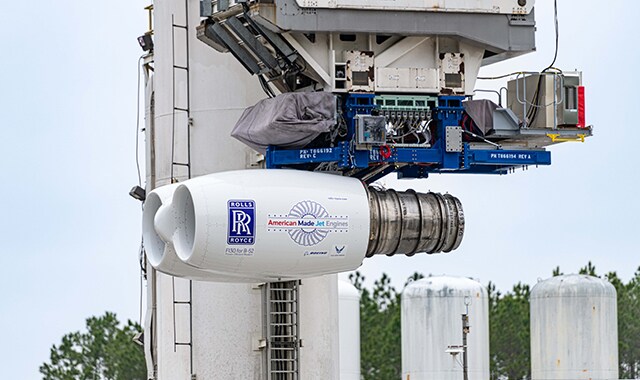Aerospace
Rolls-Royce has begun testing F130 engines for the United States Air Force B-52 fleet at the NASA Stennis

Rolls-Royce (LSE: RR., ADR: RYCEY) today announces it has launched F130 engine testing at the company’s outdoor test facility at the NASA Stennis Space Center in Mississippi, U.S. Rolls-Royce F130 engines were selected by the United States Air Force to replace the existing powerplants in the B-52 fleet, with over 600 new engine deliveries expected. This milestone test program is the first time F130 engines have been tested in the dual-pod engine configuration of the B-52 aircraft. Each B-52 aircraft has eight engines in four pods.
The engine testing will focus on crosswind aerodynamic flow as well as confirming the successful operation of the engine’s digital controls system. Early results from the testing have been very positive with additional test data to be analyzed over the next several months.
Rolls-Royce is collaborating very closely with the Air Force and Boeing, which is managing the overall engine integration and B-52 aircraft modernization program. The new engines will extend the life of the B-52 aircraft by 30 years. F130 engines are so durable they are expected to remain on the wing for the remainder of the aircraft’s life.
F130 engines will be manufactured, assembled, and tested at Rolls-Royce facilities in Indianapolis, the company’s largest production facility in the U.S. Rolls-Royce has invested $1 Billion in recent years to completely modernize manufacturing and testing facilities in Indiana, as well as for advanced technology.
F130 engines were selected for the B-52 by the Air Force in September 2021 following a competitive selection process. The F130 is derived from the Rolls-Royce BR family of commercial engines, with over 30 million hours of operation and a high-reliability rate. It’s a proven, dependable engine with a fuel-efficient design.

Aerospace
When Ratan Tata was denied entry to the airfield at the Aero India show, he waited

During our visit to Aero India 2019, we had the unexpected opportunity to see Ratan Tata at the event, which was a thrilling moment for us. However, there was a surprising hiccup when the security staff didn’t allow him to enter due to a lack of a security pass.
Despite this, he remained calm and patiently waited for about 20 minutes until a member of the Tata team brought him the required pass, after which he calmly proceeded inside. It was a humbling sight, showcasing his composed demeanor even in such situations.
Ratan Tata ji is not only a renowned industrialist but also a trained pilot, holding a pilot’s license. In 2007, he became the first Indian civilian to fly the F-16 Falcon during the Aero India show in Bangalore—a proud moment for the nation.
His passion for aviation extended beyond flying, as he played a key role in shaping India’s aerospace industry. Under his leadership, Tata ventured into manufacturing and maintaining aerospace components while upholding its legacy of quality. Notably, Tata’s collaboration with Airbus to develop and manufacture the C295 aircraft is a testament to its growing influence in the sector.
-

 Aviation2 months ago
Aviation2 months agoMicrosoft Flight Simulator Raises $3 Million to Bring Back the An-225 Mriya
-

 Airlines2 months ago
Airlines2 months agoQatar Citizens Can Travel to the United States Without a Visa
-

 Aviation2 months ago
Aviation2 months agoQatar Airways bans these new Electronic Devices on plane
-

 Airlines2 months ago
Airlines2 months agoJapan Airlines Rolls Out Free Domestic Flights to International Passengers
-

 Defence2 months ago
Defence2 months agoWhich Country Has the Largest Fleet of Fighter Aircraft?
-

 Airport2 months ago
Airport2 months agoWestern Sydney Airport Welcomes Its First Plane After 6 Years of construction
-

 Travel2 months ago
Travel2 months agoQatar Airways Launches Four Additional Flights from Amsterdam
-

 Airlines4 days ago
Airlines4 days agoDAMAC Air: Dubai’s New Luxury Airline Offers Free Flights for Registration








